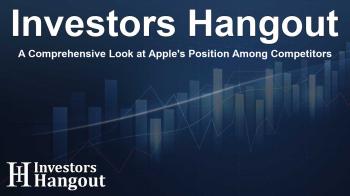A Comprehensive Look at Apple's Position Among Competitors

Examining Apple's Role in the Technology Sector
In an incredibly dynamic and competitive marketplace, making informed investment decisions requires a thorough analysis of the companies involved. This article presents a detailed comparison of Apple Inc. (NASDAQ: AAPL) and its peers in the Technology Hardware, Storage, and Peripherals sector. By looking at fundamental financial indicators, market position, and potential for growth, we aim to offer insightful perspectives on Apple's standing in the industry.
Understanding Apple Inc.
Apple is one of the largest and most influential companies worldwide, offering a diverse array of hardware and software aimed at both consumers and businesses. The brand's flagship product, the iPhone, constitutes a significant portion of its revenue. However, Apple’s ecosystem also includes devices like the Mac, iPad, and Apple Watch, all interconnected through a robust software platform. Recent efforts have been focused on expanding services such as video streaming and subscription models, as well as entering the realm of augmented reality. The firm develops its software and semiconductors, working alongside partners like Foxconn and TSMC for product manufacturing. Nearly half of Apple's revenue is generated directly through its retail locations, with a substantial portion stemming from distribution partnerships.
Financial Analysis of Apple and Competitors
| Company | P/E | P/B | P/S | ROE | EBITDA (in billions) | Gross Profit (in billions) | Revenue Growth |
|---|---|---|---|---|---|---|---|
| Apple Inc | 41.18 | 61.18 | 10.03 | 35.34% | $31.03 | $43.72 | 9.63% |
| Western Digital Corp | 31.04 | 8.92 | 5.21 | 5.21% | $0.51 | $1.07 | 29.99% |
| Hewlett Packard Enterprise Co | 28.72 | 1.32 | 0.98 | 1.14% | $1.11 | $2.67 | 18.5% |
| Pure Storage Inc | 236.61 | 24.17 | 9.86 | 3.68% | $0.09 | $0.6 | 12.73% |
| Super Micro Computer Inc | 29.98 | 4.75 | 1.44 | 3.08% | $0.26 | $0.54 | 7.51% |
| NetApp Inc | 20.45 | 23.66 | 3.63 | 23.13% | $0.38 | $1.1 | 1.17% |
| Logitech International SA | 27.45 | 8.52 | 3.87 | 7.99% | $0.22 | $0.51 | 6.27% |
| Turtle Beach Corp | 16.81 | 2.79 | 0.97 | -2.47% | $0.0 | $0.02 | -25.76% |
| Average | 55.87 | 10.59 | 3.71 | 5.97% | $0.37 | $0.93 | 7.2% |
Financial Insights for Apple
Upon reviewing Apple’s financial standing, several notable observations emerge:
The Price to Earnings (P/E) ratio stands at 41.18, indicating that Apple is trading below the industry average, suggesting room for growth.
With a Price to Book (P/B) ratio of 61.18, Apple appears to be trading at a premium, outpacing the industry average significantly.
The Price to Sales (P/S) ratio of 10.03 suggests that sales relative to stock price might indicate overvaluation when compared to competitors.
Apple’s Return on Equity (ROE) is impressive at 35.34%, reflecting the company’s efficient profit generation.
With an EBITDA of $31.03 billion, Apple is considerably above the industry average, demonstrating strong profitability.
Gross profits of $43.72 billion further illustrate Apple’s robust earnings capacity.
The company’s revenue growth of 9.63% showcases its outperformance in comparison to industry rates.
Debt Management
Debt-to-equity (D/E) ratios play a critical role in assessing a company's financial health. Apple’s D/E ratio holds steady at 1.54, placing it in a favorable position among its main competitors.
This level of debt suggests a balanced approach to leveraging equity while maintaining a manageable debt load, enhancing its financial flexibility.
Conclusion and Recommendations
Apple’s metrics within the Technology Hardware, Storage, and Peripherals sector reveal a firm that is performing well relative to its competitors, despite some indicators pointing to possible overvaluation. Investors might find the company’s robust financial performance and growth trajectory appealing options in their portfolios.
Frequently Asked Questions
1. What key metrics are analyzed when comparing Apple and its competitors?
Key metrics include Price to Earnings (P/E), Price to Book (P/B), Price to Sales (P/S), Return on Equity (ROE), earnings before interest and taxes (EBITDA), and revenue growth rates.
2. How does Apple's gross profit compare to its competitors?
Apple's gross profit of $43.72 billion is significantly higher than the industry average, indicating strong earnings from its operations.
3. What does a high ROE signify for Apple?
A high Return on Equity (ROE) of 35.34% indicates that Apple is effectively using shareholder equity to generate profits, showcasing its profitability.
4. Why is the D/E ratio important?
The Debt-to-Equity ratio is important as it helps evaluate a company's financial structure, indicating how much debt is used to finance the company's assets versus equity.
5. What trends did the analysis reveal for Apple's future growth?
The analysis suggests that Apple has favorable growth potential, particularly given its solid revenue growth and strong financial indicators.
About The Author
Contact Thomas Cooper privately here. Or send an email with ATTN: Thomas Cooper as the subject to contact@investorshangout.com.
About Investors Hangout
Investors Hangout is a leading online stock forum for financial discussion and learning, offering a wide range of free tools and resources. It draws in traders of all levels, who exchange market knowledge, investigate trading tactics, and keep an eye on industry developments in real time. Featuring financial articles, stock message boards, quotes, charts, company profiles, and live news updates. Through cooperative learning and a wealth of informational resources, it helps users from novices creating their first portfolios to experts honing their techniques. Join Investors Hangout today: https://investorshangout.com/
The content of this article is based on factual, publicly available information and does not represent legal, financial, or investment advice. Investors Hangout does not offer financial advice, and the author is not a licensed financial advisor. Consult a qualified advisor before making any financial or investment decisions based on this article. This article should not be considered advice to purchase, sell, or hold any securities or other investments. If any of the material provided here is inaccurate, please contact us for corrections.

